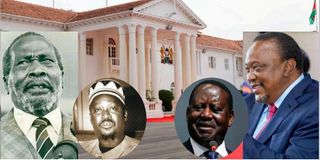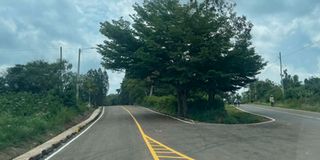President Raila? Bondo readies for an Odinga presidency

From left: Kenya's first president Mzee Jomo Kenyatta, Jaramogi Oginga Odinga, ODM leader Raila Odinga and President Uhuru Kenyatta.
There is something mystical about Bondo. The rural town famed for being Raila Odinga’s country home doesn’t jump at you at first, but rather crawls from behind before smothering you with history and bucolic innocence.
It isn’t grand. Or presidential. Or brimming with riches and glitzy maisonettes and the arrogance that comes with new money. No. Bondo just lies there in the Nyanza sun; subdued, peaceful and rustic. Just another diminutive piece of the geographical chapati that makes Kenya.
For a first-time visitor, it feels old and somewhat disorganised. In the stridency of its boda boda, fish, cereals and general rural commerce, Odinga’s rural town seems to have forgotten to shed off the lull of its rich heritage and accept the disruption of the modern age. But then again so does Gatundu, the highlands hamlet that has produced two presidents but which still retains the colonial planning and architecture of the 1950s, with a road running through it and nothing else beyond the reach of the rusting roofs. Ditto Othaya, from where former President Mwai Kibaki hailed.
Bondo, however, swims in the thick soup of politics and expectation. It is here where Raila Odinga, the Azimio la Umoja One Kenya Coalition flagbearer, retreats when the turmoil of the city becomes too much to bear. And from here, the Orange Democratic Movement party leader runs a tight political operation that has made him more than just a kingpin.
But Bondo today is doing more than just swim in the soup of politics; it is preparing for an Odinga presidency. Raila Amolo Odinga has vied for the presidency a combined 20 years. He vied unsuccessfully four times, in 1997, 2007, 2013 and 2017. If 2007, when he believed he had won the race against the incumbent Mwai Kibaki, put more wind behind his sail, 2022 is turbo-charging the hell out of him.
To him, and indeed to the vast community of those who follow him, 2022 is his best chance to become president. And it shows on the hallowed grounds he calls home. On the day we visited, we found workers doing final touches on the road leading to his homestead. The road now has a fresh layer of tarmac, a new coat of paint, and the drainage and footpaths have been redone.
Neat plants now line the driveway to the huge, imposing black gate that stands between his house and the world outside, where contracted workers have been putting the final touches on the drainage and water supply infrastructure. They have also been clearing the bushes dotting the small stretch from where the road from the main thoroughfare forks into two, with the left leg leading to the Odinga homestead.
Homes, despite conventional wisdom, have a life. They might not breathe, but even in the taciturnity of their existence they impose a sense of stateliness or austerity that is hard to miss. The spruced-up Odinga home breathes majesty and dignity even from a mile away, and even before the police sentries guarding the gate swing it open to usher one into the architectural sumptuousness of what many here believe will become the unofficial State House of Bondo.

Part of Bondo town in Siaya County. Many in Bondo are preparing for an Odinga presidency.
This region, like many in the parts of Nyanza and Western we visited, will vote overwhelmingly for Raila. If Ruto will take the Mountain and parts of Rift Valley, Raila is assured of victory here. I’m sitting on a plastic chair at a car wash station just a few metres from the Odinga homestead when I ask the man running the small business why there appears to be no campaigns frenzy here. In the din of the petrol-powered pressure machine he is using, he tells me elections in Nyanza are determined at the party primaries. Whoever wins the party ticket, in this case the ODM or Azimio-affiliated certificate, is almost assured of victory, and therefore there is scarcely any need to hit the campaign trail and burn money after that.
That, perhaps, explains the stranglehold of the Odinga family on local politics here. Other than the more famous Raila, various other kin and kith are vying for elective positions this year. His brother Oburu, who is currently a member of the Arusha-based East African Legislative Assembly, wants to be the Siaya Senator to replace James Orengo, who is vying for the governorship; while his sister Ruth wants to be the Kisumu County Woman Representative. Raila’s nephew Elijah Bonyo Oburu wants to unseat Fred Ouda in the Kisumu Central MP race, while another Odinga, Omondi, wants to be Kisumu’s Milimani Ward Member of County Assembly.
Here, like in other parts of the country, belonging to the right party or political formation is important, as is having the right lineage. In Ukambani, for instance, Kalonzo Musyoka’s Wiper Democratic Movement soars above the rest – some would say ‘punches above its weight’ – and the net effect of that association is the aggregation of votes and loyalties around the Musyoka network.
In Nyanza, Raila Odinga’s Orange Democratic Movement stands out among the many political formations that dot this vast land. It’s success over the years has been so resounding that, as an outsider observer moving around and talking to farmers, fisher folk, business people and the quintessential man on the street, one gets the feeling that the political machine here is on autopilot. And nothing, perhaps, illustrates this better than the state of the ODM office in Ugunja township, on the road to Busia from Kisumu. Nestled between two shops by the roadside, the office stands in absolute misery, its orange-yellow colours peeling in the heat of the Nyanza clime. There is little evidence of any effort to brand the party here, or at least put attractive labels on it, but as sure as the sun rises from the East, ODM remains the dominant political player here, and might remain so for the foreseeable future.
The campaigns this year have been informed largely by the cost of living. Every election, they say, has a question. In 2013 the question was whether or not to elect a lot facing criminal charges in The Hague, and in 2017 it was whether to hand that lot another five years to run the nation, which both Uhuru Kenyatta and William Ruto successfully branded as a ‘Tano Tena’ moment on whose massive ‘kumira kumira’ wave they rode to power.

The road to Azimio flag bearer Raila Odinga’s rural home in Bondo has been redone in preparation for a possible Odinga presidency.
Moving around the Raila backyard, one gets the feeling that, even in its fervent political postures, this is a region that has its act together socially. There is a sense of camaraderie in which the rural communities here are organised. Homesteads are clustered in small familial microcosms that branch out into villages, locations, sub-counties and so forth, in those ever-widening concentric circles.
To get to Bondo from Kisumu we made short stop-overs and detours into rural farmlands and fish landing bays at Kisian, Holo, Kombewa and Kolenyo, the small settlement atop a hill made famous by Gabriel Oguda on his Twitter feed. Along the way, and despite the overwhelming social bonds, there were markers of a region that is stuck to a glorious past, and which has refused to experiment with other forms of cultural, political, economic and even agrarian commotions. If one were to be blunt, one would say that Nyanza suffers from the hangovers of the golden years of the 1960s, when industry was thriving and the fish of the lake were abundant. That is why farmlands here are still dotted with the heads of sorghum and millet plants, which used to be a million-dollar enterprise in the heyday of Kenya Breweries Limited. While other regions moved to the more marketable maize staple, this region has remained stuck to the agrarian loyalties of its past, with a mixed bag of consequences.
“This is all for subsistence,” Mr Agabus Odanga, a structural and civil engineer based in Kisumu, who is my guide and fixer on this leg of the Nation’s Journey Through Kenya series, tells me. “The Luos are not farmers, generally, and so you will not find the huge tracts of commercial farmland that you would in the slopes of Mt Kenya or even next-door in Luhyaland.”
We are sitting inside a small restaurant in Bondo eating boiled fish and ugali that tastes like heaven as we exchange notes. We have just spent hours driving around and talking to everyone we could and from here we are going to take the newly tarmacked road to Siaya, cross over to Rang’ala via Ndere, and drive onwards to the border town of Busia. While we have felt the political pulse of this corner of Kenya, we still can’t quite figure out its economic motions. Agriculture is dead and fishing is dying, there is hardly any merchandising at a grand cross-county scale, yet even then, there appears to be no need for it; there isn’t widespread poverty at the scale seen in other parts of the country and the people seem and sound generally happy.
We are on the road from Bondo town to Siaya when I ask Odanga why there aren’t many vehicles on it.
“Blame it on commerce, or lack of it, precisely,” he offers. “Townships here trade with themselves, not with others, and therefore there isn’t a lot of movement of people and products across communities. This is a region talking to itself, and that to a lot of people here is what matters.”
His explanation points to a fragile ecosystem of self-sufficiency that, while good at face value, also illustrates the delicateness of the Nyanza commercial entreprise. And in there, wrapped in that self-sufficiency, are subtle toppings of political bearings that keep this region moving. An Odinga presidency would crown it all, and Nyanza can’t wait to dance in victory.
“Whichever way it goes, we will have a nilote in State House,” Odanga says.
“What do you mean,” I ask.
“This is going to be either an Odinga or a Ruto moment. They are both nilotes, one from the plains and the other from the highlands. So… yeah.”
Away in Bondo, and in Opoda, where Raila also has a farm, there is a new stately smell in the air.
This could be the moment everyone here has been waiting for. This could be the fortune and luck rolled up in one. This could be providence. The signs and the air say it all.





